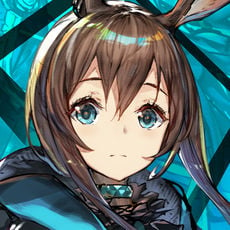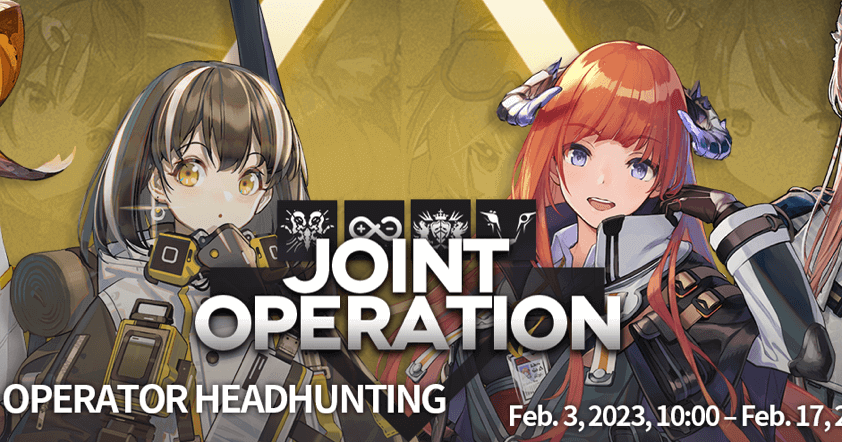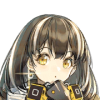Joint Operation 7 Headhunting Information
- The listed operators will be the only units available for their respective rarity
- Operator Feature Banners do not add Operators to the Distinction shop
Should You Pull?
Probably not. It’s probably better to save pulls for “Never Vowed.”
If you’re pulling on this banner, it’s with the hope of getting Bagpipe or Passenger, who are both very good (vindication for long-time Passenger fans at last!) However, Magallan and Carnelian are in an awkward spot: both are usable (and they’re also very fun for players who like their archetypes), but they can’t compare to the banners coming after this CC event.
Not only that, if you own even one of these 6★s, this banner’s appeal drops even more. Remember that the mechanics of Joint Operation banners make it easy to pull units on the banner, but hard to pull a specific unit. With that in mind, saving for the upcoming limited banners is probably a better idea.
Like with normal banners, a 5★ or higher Operator is guaranteed in the first 10 rolls. Should you pull for that? Definitely not. While three of the Operators are fairly good (La Pluma, Shamare, and Mulberry, in that order), the other three options are quite underwhelming, so the chance of getting a “good 5★” from the guaranteed roll is quite low.
Quick Overview: 6★ Operators
+ Usual archetype strengths: Great for “Limited to a smaller Squad of Operators” Challenge Modes, Contracts in CC events, or the “Integrated Strategies” roguelike event
+ E1 Talent makes her drones Invisible when they are deployed, allowing them to attack enemies undetected for several seconds
+ S1 brings strong crowd-control (her most common usage)
+ S2 offers heavy ST and AoE Arts damage
+ S3 provides physical AoE damage
= Her drones have Block-0 regardless of which Skill she uses, which is sometimes useful and sometimes inconvenient
= S2 drones can only be deployed on ground grids and S3 drones can only be deployed on ranged grids, which can limit their usefulness on some stages
- Usual archetype weaknesses: Monopolizes DP and deployment slots to deploy her drones
- Drones are fragile and easily killed off by ranged enemies after the Camouflage wears off
- Cannot recover drones that are killed by enemies unless she retreats and redeploys
+ Has great consistent DPS (S2) or burst damage (S3), both of which are useful for getting kills and generating DP
+ Works well as a heli-drop assassin
+ E1 Talent gives her attacks a chance to hit multiple targets at once (great with S2 or S3)
+ E2 Talent gives all allied Vanguards extra Initial SP (meta-defining when used with Standard Bearer Vanguards)
+ S3 greatly increases her DPS and her durability, gives her Block +1, and charges pretty quickly
= The effect of her Pot 4 Talent improvement can be very noticeable, but that means pulling multiple copies of her
- Technically suffers the flaws of her archetype: Block-1 (though S3 helps with this) and unreliable DP generation (though the benefit of her E2 Talent outweighs this)
+ Usual archetype strengths: Has “chain lightning” attacks that can jump through multiple targets if enemies are arranged correctly
+ S2 is good for sustained damage and extends the range of his damage/ Slow
+ S3 is an excellent tool for burst damage AND wave-clearing, sometimes at the same time
+ X-Module improves his SP generation as long as there are no enemies adjacent to him, making S3 much more spammable
+ Y-Module removes the “damage decay” on his chain lightning, improving his ability to clear waves
= Usual archetype dilemma: Better than a ST Caster when enemies are close together, and better than an AoE Caster when enemies are spread out, but worse when the opposite is true
= Good Modules that greatly increase his viability, but Modules are expensive and he really needs one (usually X, but Y can work as well) to contribute
- Usual archetype weaknesses: High DP cost; low base ATK and slow ASPD greatly reduces potential DPS
- High SP costs
- S3 is very impressive but can be clunky to use, thanks to high SP cost, low number of charges, and random targeting of the attacks
+ Usual archetype strengths:
- Has DEF +200% and RES +20 while her Skills are NOT active, putting her on par with multiple Defenders
- Attacks all enemies within her attack range while her Skills are active (“true” AoE)
+ Talent heals her every time she uses a Skill
+ S1 gives her a DEF bonus while active, and Charged S1 retains her Trait buff for the duration; this means that Charged S1 gives her pretty phenomenal defenses (plus a huge heal from her Talent), making this a great skill to support the Archetype’s role of “ranged tank”
+ S2 inflicts Slow and Charged S2 inflicts Bind, giving Carnelian good AoE crowd control. With ASPD buffs (i.e., Aak), Charged S2 becomes a ridiculously good stalling tool.
+ S3 has expanded attack range and ramps up damage throughout the duration; Charged S3 has even higher damage potential, absolutely destroying groups of enemies. It has a faster cycle time than most comparable Skills, so it can be available more often.
= Has pretty reasonable SP costs for her Skills, but has to build that SP twice to get the Charged effects and needs the Charged effects to be viable… so really, her SP costs are higher than they first appear
- Usual archetype weaknesses:
- Activating her Skills (except Charged S1) causes her to lose her massive survivability, forcing the player to balance “when to use her Skills” versus “when to use her as a ranged damage soak”
- Cannot attack unless a Skill is active
- Charged S3’s damage takes a long time to ramp up to maximum effect, so it’s not good for burst damage
Quick Overview: 5★ Operators
+ Typical Archetype strengths: Splash-AoE Arts damage, high base ATK
+ Can Stun enemies with her S2, which can be good for stalling
- Typical Archetype weaknesses: High DP cost, low ASPD
- S2 does a lot of damage per hit, but it actually has less DPS than S1 due to dramatically slowing her already slow ASPD
+ Usual archetype strengths: Wide attack range, high base RES, cheap DP cost
+ Talent inflicts Fragile, increasing the damage taken by nearby enemies when they are low on HP
+ S1 makes her Fragile debuff even stronger, helping to burn through meaty targets
+ S2 deploys a cursed doll that reduces ATK and DEF of enemies within its range; a great way to reduce enemy DPS and make bosses/ elites less of a threat
- Usual archetype weaknesses: Her direct DPS is so low that she is sometimes less effective than fielding another DPS unit (especially in the early game)
- Her S2 does not increase the damage dealt by Arts DPS Operators, since her doll only lowers DEF, not RES
+ Usual archetype strengths: Good stats, very low DP cost, quick redeploy timer
+ Talent empowers his next attack after not attacking for a few seconds, dealing bonus damage and Stunning the target
+ S1 passively gives him +1 Block and automatically activates when he is low on health; it prevents him from attacking or blocking and quickly recovers his HP, which also gives him a chance to charge his Talent
+ S2 is a permanent buff with a very fast charge time that gives Mr. Nothing an ATK buff and a random secondary buff:
- Mr. Nothing will debuff the ASPD of enemies he hits
- Mr. Nothing gains increased ASPD
- Mr. Nothing gains Physical Dodge and Block +1
- Usual archetype weaknesses: Constantly consumes DP, essentially negating passive DP gain (although his Module reduces the amount consumed, which is very helpful)
- The HP threshold required to activate S1 is very low, so he might die without triggering the Skill if he’s hit hard enough
- The random nature of S2 can be annoying; you won’t always have time to “re-roll” for the buff you want (and remembering what each color does can be challenging in the heat of battle)
- S2’s ATK buff is not very high
+ Usual archetype strengths: Wide attack range, high base ATK, prioritizes heavy enemies
+ Does bonus damage to Sarkaz enemies (Talent)
+ S1 reduces the target’s DEF and increases their aggro, causing allied Operators within range to prioritize that target
+ S2 does AoE damage and is good for thinning out crowds
= The “taunt” from S1 can be very effective for redirecting other Operators to target a specific enemy, but it can also pull Operators away from attacking other important targets if used thoughtlessly
- Usual archetype weaknesses: Slow attack speed reduces her overall DPS
- S1 only affects one enemy with each use
- S2’s damage is spread across two hits and it has no DEF-lowering properties, so the damage is greatly reduced against enemies with high DEF (and since heavier enemies tend to have higher DEF, she will usually target high-DEF enemies over more vulnerable targets)
+ Usual archetype strengths: Wide attack range for a melee unit (1x3); true AoE attacks; recovers HP for every enemy she hits, up to a cap of her Block count
+ A great cornerstone unit and lane holder, especially for her rarity
+ Talent increases her ASPD for every enemy she kills, up to a cap, and is usually easy to stack thanks to her strong AoE attacks
+ S1 causes her next attack to deal two stronger hits, healing her twice
+ S2 reduces her attack interval (so she can heal herself faster) and increases her ATK; her ATK is further increased against enemies with less than half HP
= Has Block-2, which is fine for actually Blocking but does limit her ability to heal herself
- Usual archetype weaknesses: Can't be healed directly (although regen does work)
- Mediocre base ATK, so she can have some trouble with high-DEF enemies
+ Usual archetype strengths: Not only heals HP but also removes Elemental Damage that allies have suffered; larger healing range than most Medic archetypes
+ Talent increases ATK of all Medic Operators when Mulberry and at least one other Medic are on the field
+ S1 charges very quickly, holds multiple charges, and greatly increases the amount of HP and Elemental Damage restored by her next heal, resulting in surprisingly high HPS
+ S2 greatly increases Mulberry’s rate of healing, changes her targeting priority to “ally with the highest Elemental Damage,” and causes all allies in Mulberry’s range to take less Elemental Damage for the duration
- Usual archetype weaknesses: Very low ATK (comparable to AoE Medics), so her HP healing is very limited
- The comparable Wandering Medic Honeyberry is currently available in the Red Certificate store
- All of her utility is related to Elemental Damage, so she loses a lot of value on maps without this mechanic
Magallan
Magallan has an army of flying drones at her beck and call, and she’s equipped them to handle a variety of tasks. However, her complex robotics are not easy to utilize. Her drones can’t Block, and each one uses both DP and a unit slot when deployed. Her Skills are powerful, but they recall all her active drones when the duration ends, forcing you to deploy them again. And the only way to recover drones that are killed by enemies is by retreating and redeploying Magallan herself, so making a mistake with her can really screw you over.
Magallan is a fun and versatile unit if you enjoy working with Summoners. Her CC with S1 is very potent, and her E1 “drone invisibility” Talent can be quite useful. However, she can’t hold a candle to limited Summoner Ling, whose minions are also versatile but much more powerful. Magallan can be noticeably trickier to use than other members of her archetype, and unfortunately her power doesn’t necessarily compensate for this complexity.
I don’t recommend pulling for Magallan unless you really like the playstyle of Summoner Supporters.
Bagpipe
Bagpipe is meta-defining. Her E2 Talent gives all Vanguards a boost to their initial SP, allowing them to activate their Skills several seconds earlier in a battle. This may not sound like much, but it’s literally a gamechanger. Being able to get DP from units like Myrtle or Texas earlier in a fight can jumpstart any and every strategy. It means getting your units down on the field faster so they can start charging their own Skills and decimating the enemy team that much more quickly.
Even if that was all Bagpipe did, she’d be great, but on top of that, she’s a terrifyingly good fighter. Her DPS is off the charts, and her E1 Talent gives her a chance to spread her damage onto multiple targets. Her charge-based S2 is a workhorse for dishing out consistent DPS, and her S3 is a monster, combining an ATK buff, a DEF buff, and Block count +1 with the ability to hit three times in one attack.
I definitely recommend pulling for Bagpipe.
Passenger
Passenger harnesses thunderstorms as weapons via a complicated array of homemade machinery. He has much in common with these storms: both are beautiful to look at, but dangerous to be around. His chain lightning attacks flicker across the field to strike unsuspecting foes at great distance, and his S3 rains awe-inspiring bolts of lightning that Slow any target they don’t instantly slay.
Multiple buffs and two powerful Module options have elevated Passenger to being unironically good at last. He does especially well in alternate modes like IS or SSS where you can stack the game’s mechanics in his favor. Passenger’s S3 gets enormous benefits from SP and/or ASPD increases, allowing him to shower wave-clearing lightning bolts like a static-charged machine gun.
I recommend pulling for Passenger.
Carnelian
Phalanx Casters are an interesting archetype to begin with, and Carnelian is an especially interesting member of the archetype. On top of the “passive and defensive when not using Skills/ fragile but unleashes AoE hell when using Skills” qualities of the archetype, Carnelian was the first unit to introduce the “Charging” mechanic, where her Skills continue to gain SP in excess of their cost and gain bonus effects once they reach double the SP cost.
When her Skills are fully charged, Carnelian can attack while retaining her defensive bonuses (S1), repeatedly crowd-control all enemies in her range (S2), or output steadily ramping AoE Arts damage on par with Eyjafjalla (S3). Her powers are potent, but they’re not easy to use: Carnelian’s Skills are lackluster if not fully Charged, which makes her Skill cycling awkward, and S3 needs multiple hits to ramp up to its full effectiveness, at which point enemies may have simply moved out of Carnelian’s range.
I don’t recommend pulling for Carnelian, but she can be worth raising if you pull her, especially if you don’t have Eyjafjalla or Passenger.
Skyfire
Poor Skyfire has always been a famously undertuned Operator. She isn’t useless by any means, but she’s something of a noob trap. When you read the description of her S2, she sounds like a harbinger of mass destruction due to its gargantuan ATK boost (+240% damage at max level!) It looks like it when you use it, too: a huge flaming meteor tears out of the sky and crushes things into a fine paste! It feels amazing.
Unfortunately, what you may not notice at first is that Skyfire’s S2 actually has lower DPS than her S1 (which is just a vanilla ATK buff and not a particularly good one). How is this possible? The problem is how the Skill slows down Skyfire’s already-slow ASPD. At such a slow speed, Skyfire’s S2 isn’t actually very good for damage. It still has use for stalling strategies due to the Stun it causes, but even there the slow ASPD can be a big inconvenience.
I don’t recommend pulling for Skyfire.
Shamare
Shamare may or may not owe her unsettling voodoo powers to her doll, Morte, but she unquestionably owes her status as a potent Supporter Operator to his participation in her S2. Shamare’s S2 allows her to place Morte on the field to decrease the ATK and DEF of all enemies around him—a deceptively simple effect, but one with devastating results.
Debuffing ATK and DEF together gives Shamare a hybrid role: she makes enemies squishier by lowering their DEF, yes, but lowering enemy ATK also makes your frontliners much more survivable. Furthermore, because Shamare’s S2 is tied to the location of her doll rather than her own placement, Shamare is very versatile with her positioning. She can sit far away from the action and still use Morte to debuff enemies at the frontlines.
I don’t recommend pulling for Shamare, but she’s very worth investing in if you pull her. She doesn’t stand out much in the early game, but she’s perfect for bosses.
Mr. Nothing
Mr. Nothing has a reputation at Rhodes Island for being able to do anything (except actual work) and you can see this in his S2, which grants him a random buff when activated and can be turned off again at will. Roll the dice as many times as you need to get the buff you want, then sit back and enjoy it for the rest of the fight!
Playing slots with Mr. Nothing’s S2 can be fun to pass the time, but it’s not the most efficient strategy. The ATK buff from the Skill is not hefty enough for Mr. Nothing to take down bulky enemies, and the randomized buffs he can receive—though a nice bonus—are rarely game-changers. In fact, considering how different they are, the three buffs are oddly interchangeable, rather than standing out with clear niches for different situations.
I don’t recommend pulling for Mr. Nothing (unless what you’re really pulling for is Junichi Suwabe’s sultry voice-acting, in which case, more power to you).
Toddifons
Considering her outfit, Toddifons doesn’t look like she’s ready for battle… until you see the colossal arbalest she carts around with her. Of course, if you can see the arbalest, it’s probably too late for you already: Toddifons is either firing a Signal Arrow that calls the attention of all of her friends, or Portable Fortcracker Arrows that do massive damage and then explode in an AoE.
Unfortunately, Toddifons’ decision to wear a skin-tight dress and high heels to the battlefield might explain why her actual combat performance isn’t that great. Between slow ASPD, a Talent that only affects one type of enemy, and surprisingly small-scale Skills, Toddifons doesn’t often pull her weight in a fight. Her S1 only affects one enemy per use and her S2’s damage is split across two hits, greatly reducing her effectiveness against enemies with high DEF—especially since, unlike 6★ Rosa, Toddifons doesn’t ignore part of her enemy’s DEF.
I don’t recommend pulling for Toddifons.
La Pluma
La Pluma is a quiet, scatterbrained kind of girl, and she’s not always the best at solving problems. This may be because her first reaction is chopping problems in half with her scythe. Having grown up in the middle of a war, La Pluma knows how to hold off large numbers of opponents all by herself, and she does it as Rhodes Island’s first Reaper Guard—mowing down foes by the bushel and draining their life force to heal herself as she does so.
La Pluma is refreshingly simple: Enemies walk into her range and she hits them. Hitting them gives her health so she can keep hitting them. If she kills them, she gets better at hitting the next batch. The great part is, her simplicity doesn’t come at the sacrifice of power. La Pluma is really good at hitting things.
I recommend pulling for La Pluma.
Mulberry
Mulberry became a Catastrophe Messenger against her family’s wishes, but it was all worth it for the day she overheard her father bragging about how proud he was of her accomplishments to the neighbors. This timid wallflower may not seem like somebody who would keep her head in a crisis, but you may change your mind once you see how stabilizing her healing influence can be during an onslaught of Elemental Damage.
Mulberry is an extremely good healer, but she’s also very comparable to fellow Wandering Medic Honeyberry, who is currently available in the Red Certificate store. Honeyberry tends to be worse at healing HP than Mulberry, but she is very comparable for recovering Elemental Damage, especially when multiple Operators are being simultaneously affected.
I don’t recommend pulling for Mulberry. She’s very good, but Honeyberry can usually do the same jobs.






























